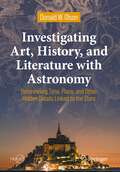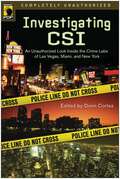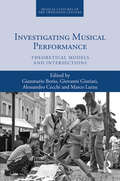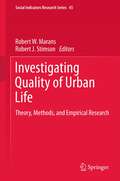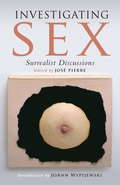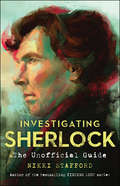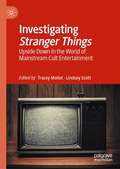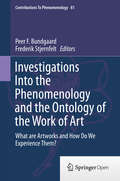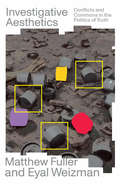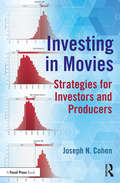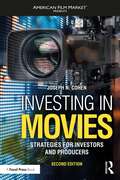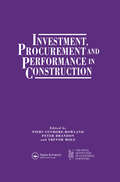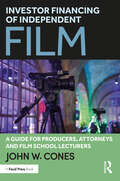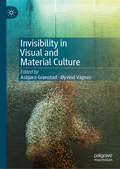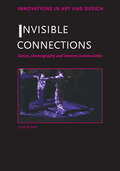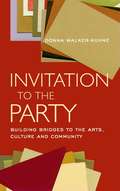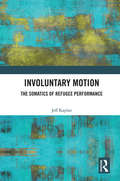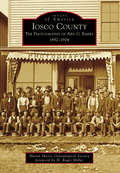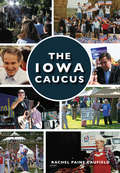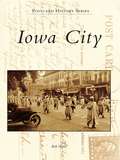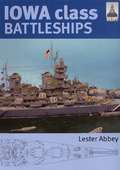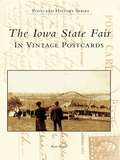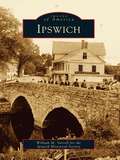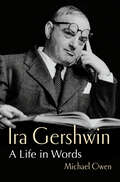- Table View
- List View
Investigating Art, History, and Literature with Astronomy: Determining Time, Place, and Other Hidden Details Linked to the Stars (Springer Praxis Books)
by Donald W. OlsonHow can shadows determine the date and time of a painting by Johannes Vermeer? How did the Moon and tides cause the loss of King John’s crown jewels? In his newest book, Professor Olson, author of Celestial Sleuth and Further Adventures of the Celestial Sleuth, explores how astronomical clues can uncover fascinating new details about art, history, and literature. He begins with an accessible introduction to amateur “celestial sleuthing,” showing how to use your astronomical knowledge, software, archives, vintage maps, historical letters and diaries, military records, and other resources to investigate the past. Follow along as Professor Olson then explores twenty real-world cases where astronomy has helped answer unresolved questions or correct longstanding interpretations about an event. Examples involve artists such as Vermeer, Monet, and O’Keeffe; the historical exploits of Alexander the Great, the desert travels of the Death Valley ’49ers, and a meeting between Franklin D. Roosevelt and Winston Churchill in Marrakech; and literary works by Chaucer, Shakespeare, and Longfellow. Packed with dozens of full-color illustrations, this book will enrich your knowledge of the past and equip you with all the tools you’ll need to become a celestial sleuth yourself. “Many people have a passion for art, or world history, or great literature, or even astronomy — but seldom in all these things at once. This remarkable book by Donald Olson of Texas State University will put you in touch with such seemingly unrelated endeavors. It will open your eyes and broaden your mind as little else could.” Roger W. Sinnott, Sky & Telescope
Investigating CSI: Inside the Crime Labs of Las Vegas, Miami and New York
by Donn Cortez with Leah WilsonThis selection of smart, accessible essays covers CSI's cutting-edge science, intriguing mysteries, and engaging personal dynamics. Essays from experts in the field illuminate such processes as DNA testing, ballistics, crime-scene photography, and autopsy procedure. With pieces that focus on the leads' varying appeals, the history of forensics on television, the show's treatment of alternate sexualities, and whether the incredible attention to detail actually gives criminals an advantage, this anthology provides an in-depth investigation that enriches the viewing experience.
Investigating Musical Performance: Theoretical Models and Intersections (Musical Cultures of the Twentieth Century)
by Gianmario Borio Giovanni Giuriati Alessandro Cecchi Marco LutzuInvestigating Musical Performance considers the wide range of perspectives on musical performance made tangible by the cross-disciplinary studies of the last decades and encourages a comparison and revision of theoretical and analytical paradigms. The chapters present different approaches to this multi-layered phenomenon, including the results of significant research projects. The complex nature of musical performance is revealed within each section which either suggests aspects of dialogue and contiguity or discusses divergences between theoretical models and perspectives. Part I elaborates on the history, current trends and crucial aspects of the study of musical performance; Part II is devoted to the development of theoretical models, highlighting sharply distinguished positions; Part III explores the relationship between sign and sound in score-based performances; finally, the focus of Part IV centres on gesture considered within different traditions of musicmaking. Three extra chapters by the editors complement Parts I and III and can be accessed via the online Routledge Music Research Portal. The volume shows actual and possible connections between topics, problems, analytical methods and theories, thereby reflecting the wealth of stimuli offered by research on the musical cultures of our times.
Investigating Quality of Urban Life
by Robert J. Stimson Robert W. MaransThe study of quality of urban life involves both an objective approach to analysis using spatially aggregated secondary data and a subjective approach using unit record survey data whereby people provide subjective evaluations of QOL domains. This book provides a comprehensive overview of theoretical perspectives on QOUL and methodological approaches to research design to investigate QOUL and measure QOL dimensions. It incorporates empirical investigations into QOUL in a range of cities across the world.
Investigating Sex
by Jose Pierre Dawn AdesIn January 1928, the surrealists initiated their remarkable "researches into sexuality" with a series of round-table conversations involving key figures such as André Breton, Yves Tanguy, Louis Aragon, Man Ray, Max Ernst and Antonin Artaud. The transcripts, in all their bizarre and fascinating detail, are presented here. While there is plenty of humor--not all of it intentional--the speakers were trying scrupulously to record every aspect of sexual love, cataloging preferences and positions, quality and quantity. This book is a unique historical record of sexual practice and ethics; a fundamental text for understanding the surrealist movement and, for all its idiosyncrasies, a document that still retains an extraordinary vitality today.From the Hardcover edition.
Investigating Sherlock: The Unofficial Guide
by Nikki StaffordAn &“intelligent and lively&” companion to the hit BBC show starring Benedict Cumberbatch (Publishers Weekly). He&’s been depicted as a serious thinker, a master of deduction, a hopeless addict, and a bare-knuckle fighter. His companion is a bumbler, a sympathetic equal, someone helpless in the face of his friend&’s social inadequacies. Sherlock Holmes and John Watson remain the most-adapted fictional characters of all time. In 2010, when Benedict Cumberbatch and Martin Freeman stepped into the roles, they managed to meld many previous incarnations into two glorious performances. Over Sherlock&’s first three seasons, the Emmy Award–winning series has brought new life to stories over a century old and, with its Holmes and Watson for the twenty-first century, created a worldwide phenomenon. Investigating Sherlock examines each episode through in-depth and fun analysis, exploring the character development and cataloguing every subtle reference to the original stories. With biographies of Cumberbatch and Freeman, as well as Arthur Conan Doyle, Investigating Sherlock is great fun, and the ultimate guide to the great detective. &“One of the best-researched books out there on the BBC Show, with great interviews of the show&’s creators and primary actors.&” —GeekDad
Investigating Stranger Things: Upside Down in the World of Mainstream Cult Entertainment
by Tracey Mollet Lindsey ScottThis edited collection explores the narrative, genre, nostalgia and fandoms of the phenomenally successful Netflix original series, Stranger Things. The book brings together scholars in the fields of media, humanities, communications and cultural studies to consider the various ways in which the Duffer Brothers’ show both challenges and confirms pre-conceived notions of cult media. Through its three sections on texts, contexts and receptions, the collection examines all aspects of the series’ presence in popular culture, engaging in debates surrounding cult horror, teen drama, fan practices, and contemporary anxieties in the era of Trump. Its chapters seek to address relatively neglected areas of scholarship in the realm of cult media, such as set design, fashion, and the immersive Secret Cinema Experience. These discussions also serve to demonstrate how cult texts are facilitated by the new age of television, where notions of medium specificity are fundamentally transformed and streaming platforms open up shows to extensive analysis in the now mainstream world of cult entertainment.
Investigations Into the Phenomenology and the Ontology of the Work of Art
by Frederik Stjernfelt Peer F. BundgaardThis book investigates the nature of aesthetic experience and aesthetic objects. Written by leading philosophers, psychologists, literary scholars and semioticians, the book addresses two intertwined issues. The first is related to the phenomenology of aesthetic experience: The understanding of how human beings respond to artworks, how we process linguistic or visual information, and what properties in artworks trigger aesthetic experiences. The examination of the properties of aesthetic experience reveals essential aspects of our perceptual, cognitive, and semiotic capacities. The second issue studied in this volume is related to the ontology of the work of art: Written or visual artworks are a specific type of objects, containing particular kinds of representation which elicit a particular kind of experience. The research question explored is: What properties in artful objects trigger this type of experience, and what characterizes representation in written and visual artworks? The volume sets the scene for state-of-the-art inquiries in the intersection between the psychology and ontology of art. The investigations of the relation between the properties of artworks and the characteristics of aesthetic experience increase our insight into what art is. In addition, they shed light on essential properties of human meaning-making in general.
Investigative Aesthetics: Conflicts and Commons in the Politics of Truth
by Matthew FullerA new field of counterinvestigation across in human rights, art and lawToday, artists are engaged in investigation. They probe corruption, human rights violations, environmental crimes and technological domination. At the same time, areas not usually thought of as artistic make powerful use of aesthetics. Journalists and legal professionals pore over opensource videos and satellite imagery to undertake visual investigations. This combination of diverse fields is what the authors call &“investigative aesthetics&”: the mobilisation of sensibilities associated with art, architecture and other such practices in order to speak truth to power. Investigative Aesthetics draws on theories of knowledge, ecology and technology; evaluates the methods of citizen counter-forensics, micro-history and art; and examines radical practices such as those of WikiLeaks, Bellingcat, and Forensic Architecture. These new practices take place in the studio and the laboratory, the courtroom and the gallery, online and in the streets, as they strive towards the construction of a new common sense. Matthew Fuller and Eyal Weizman have here provided an inspiring introduction to a new field that will change how we understand and confront power today.
Investing in Movies: Strategies for Investors and Producers
by Joseph N. CohenInvesting in Movies: Strategies for Investors and Producers is a useful guide for investors and producers looking for an analytical framework to assess the opportunities and pitfalls of film investments. The book traces macroeconomic trends and the globalization of the business, as well as the impact these have on potential returns. It offers a broad range of guidelines on how to source interesting projects and advice on what kinds of projects to avoid, as well as numerous ways to maximize risk-adjusted returns. While focusing primarily on investments in independent films, industry veteran and author Joseph Cohen also provides valuable insights into the studio and independent slate deals that have been marketed to the institutional investment community. Features of this book include: A guide to the minefield of film investing for the potential investor, giving students and aspiring professionals an insider perspective; A detailed explanation of the risk and rewards inherent in the film business and how to evaluate projects; Thorough coverage of the cast of characters that populate the film space, and advice on building relationships to optimize opportunities.
Investing in Movies: Strategies for Investors and Producers (American Film Market Presents)
by Joseph N. CohenIn this second edition of Investing in Movies, industry veteran Joseph N. Cohen provides investors and producers with an analytical framework to assess the opportunities and pitfalls of film investments. The book traces macroeconomic trends and the globalization of the business, including the rise of streamers, as well as the impact these have on potential returns. It offers a broad range of guidelines on how to source interesting projects and advice on what kinds of projects to avoid, as well as numerous ways to maximize risk-adjusted returns. While focusing primarily on investments in independent films, Cohen also provides valuable insights into the studio and independent slate deals that have been marketed to the institutional investment community. As well, this new edition has been updated to fully optimize the current film industry climate including brand new chapters on the Chinese film market, new media/streaming services, and the effects of COVID-19 on the global film market. Written in a detailed and approachable manner, this book is essential for students and aspiring professionals looking to gain an insider perspective against the minefield of film investing.
Investment, Procurement and Performance in Construction: The First National RICS Research Conference
by P.S. Brandon T. Mole P. Venmore-RowlandThe proceedings of a major conference on the built environment ran by the RICS to examine recent research and development in: investment; building procurement and construction; and building performance analysis.
Investor Financing of Independent Film: A Guide for Producers, Attorneys and Film School Lecturers
by John W. ConesThis book explains how to comply with the federal and states securities regulations when seeking to raise money from private investors for the development, production and/or distribution of a feature or documentary film. Drawing from the experience and expertise of a securities and entertainment attorney who has worked with independent filmmakers for 30 plus years, this resource explores securities law compliance in order to help readers comply with the law and avoid criminal and civil liability, while successfully raising investor funds for their film projects. Readers will gain an understanding of why the securities laws apply to most investor financing transactions, what choices need to be made by the filmmaker, what information needs to be disclosed to prospective investors, how to comply with the SEC’s policy regarding financial projections, what is the appropriate investment vehicle for various forms of investor financing, what limitations are imposed on the use of finders and how to handle the required federal and state notice filings. It is an essential resource for any film student taking a film finance course (or a production course with a film finance component), as well as any independent film producers, entertainment/securities attorneys and film school instructors, who want to be informed about the legal and practical aspects of investor financing of independent films.
Invisibility in Visual and Material Culture
by Øyvind Vågnes Asbjørn GrønstadThe essays in Invisibility in Visual and Material Culture contribute pioneering and revelatory insights into the phenomenon of invisibility, forging new and multi-disciplinary approaches at the intersection of aesthetics, technology, representation and politics. Importantly, they acknowledge the complex interaction between invisibility and its opposite, visibility, arguing that the one cannot be fully grasped without the other. Considering these entanglements across different media forms, the chapters reveal that the invisible affects many cultural domains, from digital communication and operative images to the activism of social movements, as well as to identity, race, gender and class issues. Whether the subject is comic books, photographic provocations, biometric and brainwave sensing technologies, letters, or a cinematic diary, the analyses in this book engage critically and theoretically with the topic of invisibility and thus represent the first scholarly study to identify its importance for the field of visual culture.
Invisible Connections: Dance, Choreography and Internet Communities (Innovations In Art And Design Ser.)
by Sita PopatThe first and only book to focus on dance on the Internet, Sita Popat‘s fascinating Invisible Connections examines how Internet and communication technologies offer dance and theatre new platforms for creating and performing work, and how opportunities for remote interaction and collaboration are available on a scale never before imaginable.Drawing
Invisible Storytellers: Voice-Over Narration in American Fiction Film
by Sarah KozloffSarah Kozloff examines and analyzes voice-over narration through examples from films and refutes the assumptions that words should only play a minimal role in film, that "showing" is superior to "telling," or that the technique is inescapably authoritarian.
Invitation to the Party
by Donna Walker-Kuhne George C. WolfeAcknowledged as the nation's foremost expert on audience development involving America's growing multicultural population by the Arts and Business Council, Donna Walker-Kuhne has now written the first book describing her strategies and methods to engage diverse communities as participants for arts and culture. By offering strategic collaborations and efforts to develop and sustain nontraditional audiences, this book will directly impact the stability and future of America's cultural and artistic landscape. Donna Walker-Kuhne has spent the last 20 years developing and refining these principles with such success as both the Broadway and national touring productions of Bring in 'Da Noise, Bring in 'Da Funk, as well as transforming the audiences at one of the U.S.'s most important and visible arts institutions, New York's Public Theater. This book is a practical and inspirational guide on ways to invite, engage and partner with culturally diverse communities, and how to enfranchise those communities into the fabric of arts and culture in the United States.Donna Walker-Kuhne is the president of Walker International Communications Group. From 1993 to 2002, she served as the marketing director for the Public Theater in New York, where she originated a range of audience-development activities for children, students and adults throughout New York City. Ms. Walker-Kuhne is an Adjunct Professor in marketing the arts at Fordham University, Brooklyn College and New York University. She was formerly marketing director for Dance Theatre of Harlem. Ms. Walker-Kuhne has given numerous workshops and presentations for arts groups throughout the U.S., including the Arts and Business Council, League of American Theaters and Producers, the Department of Cultural Affairs, and the National Endowment for Arts to name a few. She has been nominated for the Ford Foundation's 2001 Leadership for a Changing World Fellowship.
Involuntary Motion: The Somatics of Refugee Performance
by Jeff KaplanInvoluntary Motion contributes to the study of refugee flight by using movement as a lens to explore problems in refugee performance and understand the experience of bodies in motion. Drawing from Somatics, Movement Analysis, and dance praxis, the chapters explore forces that set bodies in motion; the spaces in which forced movement occurs; the movement of refugee identity arcs; the monstrosity of refugee performance; and the relationship between writing and body culture. How does forced movement impact identity? What are the philosophical implications of robbing agency over motion? What performances does involuntary motion necessitate? These questions are important as the world confronts the threat of a return of the horrors of the Twentieth Century. Bringing together debates in Migration Studies and Movement Studies, the book argues that refugees are akin to dancers performing on disappearing stages, not of their choosing. It will be of great interest to students and scholars of performance, dance and politics.
Iosco County: The Photography of Ard G. Emery 1892-1904
by H. Roger Miller Huron Shores Genealogical SocietyIn 1892, artistic photographer Ard G. Emery established a studio and gallery business in a bustling East Tawas community overlooking Lake Huron on the sunrise side of Iosco County, Michigan. For 12 years, Emery captured the culture and history of the area through his camera lens. His collodion glass negatives celebrated personal triumphs, honored the strength of the working man, and saluted the candidness of the young. Emery used the most modern techniques and finest materials, but he was fascinated by the ordinary. Emery often journeyed with his travelling studio to the countryside to photograph the everyday life of normal people. Zealous about his craft, Emery not only preserved days gone by, but he also preserved his own spirit--one that will be forever remembered in Iosco County.
Iowa Caucus, The (Images of Modern America)
by Rachel Paine CaufieldFor more than 40 years, Iowa has held the first-in-the-nation presidential caucuses. A vibrant political culture has emerged as a result of this role, and Iowa voters have a unique opportunity to get to know the nation's presidential candidates as they travel the state, attend small-group meetings, and hone their messages. Candidates come to Iowa--where "retail politics" is the name of the game--early and often. But the campaign trail in Iowa isn't just about candidates. It's about average Americans in small-town diners, church basements, and high school gyms. In an age of public cynicism about politics, the Iowa caucuses continue to demonstrate the importance of real people talking about issues with would-be presidents.
Iowa City (Postcard History)
by Bob HibbsAfter raucous times on the western frontier during the 1840s and 1850s, Iowa City settled into a relatively sleepy existence while its principal industry, the University of Iowa, was finding its way from obscurity into an important Iowa resource. Its once-too-small-to-succeed university hospital has blossomed into a medical and economic powerhouse. Research in widely varied fields, from space science to microbiology, finds fertile grounds and minds. Big Ten football beckons on fall Saturdays.
Iowa Class Battleships
by Lester AbbeyThe 'ShipCraft' series provides in-depth information about building and modifying model kits of famous warship types. Lavishly illustrated, each book takes the modeller through a brief history of the subject class, highlighting differences between sister-ships and changes in their appearance over their careers. This includes paint schemes and camouflage, featuring colour profiles and highly-detailed line drawings and scale plans. The modelling section reviews the strengths and weaknesses of available kits, lists commercial accessory sets for super-detailing of the ships, and provides hints on modifying and improving the basic kit. This is followed by an extensive photographic gallery of selected high-quality models in a variety of scales, and the book concludes with a section on research references books, monographs, large-scale plans and relevant websites.The Iowa class were the largest, fastest and most modern US battleships of the war, and the formal surrender of Japan was signed on the deck of one of them, USS Missouri. Modernised post-war, they served in Korea, Vietnam and as late as the first Gulf War. They are among the most popular subjects of all for model kits.
Iowa State Fair: In Vintage Postcards, The (Postcard History Series)
by Ron PlayleEach August, the Iowa State Fairgrounds, home to America's quintessential state fair, becomes 400 acres of sights, sounds, and aromas. More than just a showcase for farm machinery, the fair has one of the world's largest livestock shows, hundreds of competitive events, first-class entertainment, and ever imaginable food-on-a-stick. The first Iowa State Fair, held in 1854 at Fairfield, drew 10,000 visitors, and attendance now tops one million each year. Listed on the National Register of Historic Places, it has been held at its present location in Des Moines since 1886. In the early 1900s, fairgoers could choose from a large selection of postcards, stick on a penny stamp, and mail them to friends to describe their blue ribbon, an exciting midway ride, or the great entertainment. Over 190 vintage postcards provide glimpses of the fair from the 1890s to the mid-1950s in The Iowa State Fair.
Ipswich: No. 1-6 (Images of America)
by Ipswich Historical Society William M. VarrellFounded in 1634, Ipswich is one of the oldest towns in America. It currently has more First Period houses still lived in than any other community in the United States. It was originally the home of Colonial governors, renowned furniture makers, sea captains, and the Heard family, who were giants in the China trade. Added to the early settlers were immigrant millworkers and millionaires who built summer mansions. As nearby towns with broader rivers and deeper harbors became commercial successes, Ipswich went into decline. It was this "hibernation" that enabled Ipswich to maintain its earliest homes, spectacular scenery, and local charm.Through more than two hundred vintage images, Ipswich takes the reader on an exciting journey through the history of this unique town. It presents the town's creative artists, the lives and occupations of its everyday citizens, beautiful landscapes, the mills and the country stores, and the ships and shipwrecks that met the Ipswich coast.
Ira Gershwin: A Life in Words
by Michael OwenThe man behind some of the most memorable lyrics in the Great American Songbook steps from behind his brother’s shadow. The first lyricist to win the Pulitzer Prize, Ira Gershwin (1896–1983) has been hailed as one of the masters of the Great American Songbook, a period which covers songs written largely for Broadway and Hollywood from the 1920s to the 1950s. Now, in the first full-length biography devoted to his life, Michael Owen brings Ira out at last from the long shadow cast by his younger and more famous brother George. Drawing on extensive archival sources and often using Ira’s own words, Owen has crafted a rich portrait of the modest man who penned the words to many of America’s best-loved songs, like “Fascinating Rhythm,” “Embraceable You,” and “They Can’t Take That Away from Me.” These fruits of Ira’s lyric genius sprang from the simplest of seeds: a hand-drawn weekly created for a cousin, an amateur newspaper co-written with friend and future lyricist Yip Harburg, columns in the school papers at Townsend Harris High School and, later, City College of New York. The details of his early literary efforts demonstrate both his developing ambition and the early signs of his talent. But while the road to becoming a successful lyricist was neither short nor smooth, it did lead Ira to the greatest creative partnership of his life. George and Ira Gershwin collaborated on a string of hit Broadway shows in the 1920s and 1930s that resulted in popular and financial success and spawned a long string of songs that have become classics. Owen offers fascinating glimpses of their creative process, drawing on Ira’s diaries and other contemporary sources, as well as the close relationship between the two brothers. Hollywood soon beckons and the brothers head west to California to work in the movie business. Greater fame and fortune seem right around the corner. George Gershwin died in a Los Angeles hospital in July 1937. He was only 38 years old. His death marked a stark dividing line in Ira’s life, and from that point on much of his time and energy was devoted to the management of his brother’s estate and the care of his legacy. Accustomed to living in his brother’s shadow, it now threatened to overwhelm him. He worked to balance all the administrative tasks with a new series of collaborations with composers like Kurt Weill, Jerome Kern, Harry Warren, and Harold Arlen. Ira’s last Broadway work was in 1946, and several films and a book project—a collection of his lyrics with the stories behind them—occupied his later years along with the ongoing management of George’s affairs. Ira Gershwin’s work with George left an enduring mark on American culture, as recognized by the Library of Congress in 2007 when it established the Gershwin Prize for Popular Song, which has been awarded to artists like Paul Simon, Carole King, Tony Bennett, Paul McCartney, and Elton John. In Ira Gershwin: A Life in Words, Michael Owen brings the publicity shy lyricist into the spotlight he deserves.
